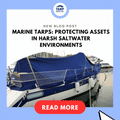A hurricane’s destructive power brings high winds, torrential rain, and flying debris—and can leave homes severely damaged. In such moments, tarps are more than just protective covers—they’re lifelines that offer immediate protection when you need it most. Here are 7 critical ways tarps can safeguard your home and help you recover from hurricane damage:
1. Temporary Roof Covering
Hurricane winds can rip off sections of your roof, exposing your home to water damage. A heavy-duty waterproof tarp across compromised areas can prevent rain from entering -providing an essential barrier until permanent repairs can be made.
2. Window and Door Protection
Windows are vulnerable entry points for wind and debris during storms. Tarps can be fastened over windows and doors to help block flying objects and minimize structural damage.
3. Flood Diversion and Water Barrier
Use tarps to create temporary barriers or channels to divert flood waters away from your home’s foundation, crawlspaces, or doors. This simple step can minimize interior water intrusion.
4. Shielding Outdoor Belongings
Patios, gardens, or storage areas can suffer from windborne debris and soaking rain. Tarps cover and protect outdoor furniture, grills, and supplies, keeping them dry and intact.
5. Securing Loose Items
High winds can turn items like firewood, bins, or bikes into hazards. Wrapping or anchoring these items with tarps reduces shifting and keeps them from becoming airborne projectiles.
6. Emergency Shelter Creation
In extreme situations, tarps can be set up as makeshift shelters—protecting against rain, sun, or wind when traditional shelter is compromised.
7. Post-Hurricane Makeshift Roofing
After a hurricane, many survivors rely on blue roof tarps to cover damaged roofs and prevent further water damage. Notably, the U.S. Army Corps of Engineers’ Blue Roof Program in Florida deployed tarp-covered roofs immediately after Hurricane Milton, ensuring homes remained watertight until full repairs were feasible.
Real-Life Example: Tarps in Survival Situations
Following Hurricane Maria in Puerto Rico, thousands of households were left without roofs. Tarps became a vital temporary solution. Although FEMA and NGOs distributed tarps, the response suffered from insufficient coordination, leaving many residents exposed to worsening conditions.
Recommended Tarp of Tarp Supply Inc.®
FEMA-quality tarp

Built to withstand the toughest conditions, our FEMA quality tarps are the ultimate solution for emergency protection and heavy-duty coverage. Popularly used as hurricane tarps, storm tarps, roof covers, boat covers, pool covers, and shelter tarps, they deliver reliable strength when it matters most.
Crafted from industrial-strength woven polyethylene, these tarps are 16 mil thick with a 14x14 weave count and 6 oz per square yard weight. They are fully waterproof, arctic flexible, and resistant to wind, rot, tear, and mildew. For added durability, each tarp features heavy-duty triangular patch reinforcements and rust-resistant brass grommets every 24 inches and at every corner—ensuring a secure hold even in extreme weather.
Perfect for disaster recovery, outdoor protection, and long-lasting shelter solutions, these tarps are trusted for their durability, strength, and FEMA-grade quality.
Conclusion
Tarps are versatile, affordable, and essential when hurricanes strike. From temporary roofing and window protection to creating shelters and securing items—having quality tarps on hand can make a profound difference.
At Tarp Supply Inc.®, we offer a full line of heavy-duty hurricane tarps—UV-treated, waterproof, and government-standard ready. Whether you're preparing for storms or recovering from one, our tarps are built to protect your home and your peace of mind.






